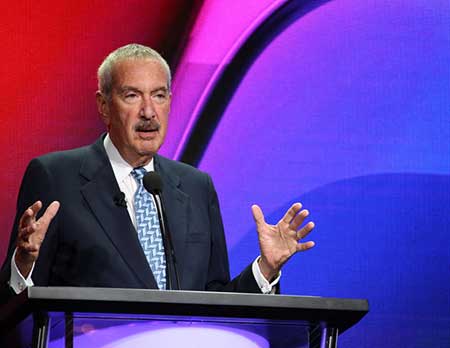TCA: NBC Sets In-Season Stacking of All But Two Fall Prime Shows

Complete Coverage: TCA Summer 2016
NBC will offer viewers full in-season stacking of its entire fall primetime lineup except for The Blacklist and Law & Order: Special Victims Unit, research chief Alan Wurtzel confirmed during a wide-ranging research session at TCA summer press tour.
Two data points in particular from Wurtzel’s array of stats spoke to the decision to pursue stacking (aka “banking”) rights. First, the network found that 75% of viewers it polled agreed with the statement, “I would watch more broadcast primetime if TV networks made it easier for me to catch up online or on demand.” Also, 54% of total viewers indicated they would not start watching a new show if they were unable to watch past episodes.
Related: Greenblatt Says NBC on Verge of Expanding OTT Far Beyond ‘Toe in Water’
As live viewing erodes, the on-demand arena has bedeviled the traditional networks. Deep pocketed SVOD players offer to pay up to nine figures for rights to some shows, forcing profit-driven companies to starve their own distribution pipeline and inconvenience viewers who don’t tune in live. As Wurtzel put it, “That’s a big deal. I had a third grade teacher, Mrs. Herschel, who said, ‘A word to the wise is sufficient.’”
The study, titled New Rules, New Behaviors (And Some Misconceptions), uses data from proprietary NBC polls over the past month of roughly 1,200 correspondents (mostly online) as well as data from Symphony and Nielsen.
Related: NBC Slots Tony Bennett Birthday Bash
The smarter way to stay on top of broadcasting and cable industry. Sign up below
Wurtzel was asked by B&C after the session whether the findings allayed his past concerns that traditional networks were effectively training viewers to look elsewhere for content. “In the case of banking, that’s really a business decision,” Wurtzel said. “It’s easy for me to say to do it. They had to go and make the deal. The reason they did is that they realized if we don’t, we are going to lose these people. Especially with the younger guys, we’re not going to bring them into the tent if we don’t appeal to them in their native world.”
Penetration of technology across the board, from smartphones to internet to OTT and smart TVs, has exceed 40% in aggregate—and 40% is the customary threshold, Wurtzel said, where a given piece of technology is considered mainstream.
Related: NBC's Bell Says Brazil Headwinds Only Enhance Games' Appeal
Roughly 80% of viewers polled agreed with the statement, “I am watching TV shows much differently than I did several years ago.” Roughly the same percentage said they’d be watching differently several years from now. And a robust 86% of respondents said they were “much more comfortable” with the way they watch TV now compared with in the past.
Because of that last point, largely chalked up to convenience, “viewing has remained solid as a rock,” Wurtzel said. In 2000, total daily video viewing totaled 4 hours 55 minutes. In 2007, it had shot up to 5 hours 24 minutes. In 2016, it ticked up to 5 hours 26 minutes per day.
Related: Jimmy Fallon to Host Golden Globes
While on-demand viewing is here to stay, the percentage of households with DVRs has stalled out in the low 50s over the past few years. “The reign of the DVR is about to end,” Wurtzel said.
Intriguingly, cross-platform viewing appears to be somewhat overstated, per the study. Using Superstore, NBC’s breakout comedy from midseason, Wurtzel said viewers tend to “stay in their lane,” with 73% of viewers watching only on linear, 18% only on OTT or VOD four-plus days after air and only 9% either way. Fully 75% agreed with the statement, “Once I decide I like a show, I stick with one way of watching.”
Related: Simon Cowell to Return as ‘AGT’ Judge
Arguing that SVOD viewing is a “complement, not a replacement” for linear viewing, Wurtzel said 80% of viewing in primetime occurs on linear broadcast or cable, with just 13% on SVOD. He also said The Blacklist ranked fourth on a list of most-binged shows, with 43% of viewers reporting they watched five-plus episodes in a week, trailing only House of Cards, Orange Is the New Black and Making a Murderer.
Wurtzel also laid out some numbers to make the case for extra-long-tail ratings performance over 119 days, or roughly four months. Superstore, he showed, accrued a 4.8 rating among adults 18-49 compared with an episode of The Voice at 5.0, keyed by 18-24-year-old viewing, 73% of which came via OTT or SVOD and often well after linear premiere.
Related: Olympics Executive Producer Downplays Rio Concerns
The data suggested to Wurtzel a rethink of promotion was overdue. “The idea that you can just open up a show is not enough anymore,” he said. “You may have to refresh it and remind people about it because they’re willing to watch it all the way down that very long tail.”
